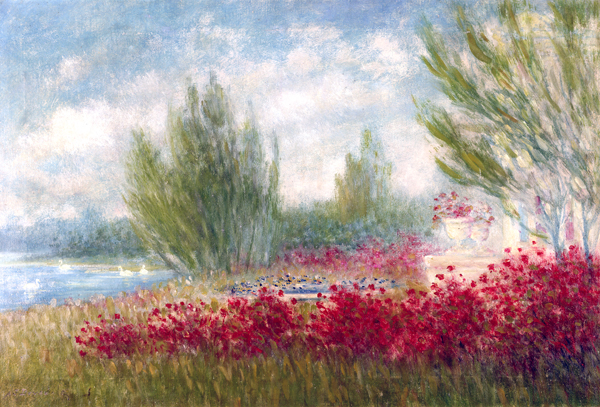Alexander Drysdale
Although Alexander Drysdale described himself as a portrait painter, he was known primarily for his landscapes depicting Louisiana's marshes and bayous.

Courtesy of Roger H. Ogden Collection.
In this painting entitled "Sunlit morning, June roses, City Park" Alexander Drysdale employes his signature style create this hazy view of a City Park landscape.
Although Alexander Drysdale described himself as a portrait painter, he was known primarily for his landscapes depicting Louisiana marshes and bayous in the early decades of the twentieth century. His characteristically hazy images of moss-draped trees and misty swamplands were created by using what became known as his “watercolor” technique, sometimes referred to as an “oil wash,” which he had developed by 1916. Forced to economize, Drysdale began to dilute oil paint with kerosene and apply it to sized board with brushes and cotton balls. The effect, he believed, was similar to that produced by the Impressionists.
Born in Marietta, Georgia, on March 2, 1870, the painter spent his childhood in Mobile, Alabama, moving to New Orleans with his family when he was thirteen. Although he expressed interest in painting as a child, he did not take it up as a career until he had tried other lines of work. He studied accounting with a private tutor while he took art lessons with Ida Hackell at the Southern Art Union at night. In 1886, he went to work as a clerk in a hardware store for two years, then took a job as a runner and later as a teller at the New Orleans National Bank. At the same time, he continued his studies with Paul Poincy and other leading painters of the city. By showing his work at thirteen consecutive exhibitions of the Artists’ Association of New Orleans, he drew so much attention that in 1901 he left banking and moved to New York City where he studied at the Art Students League with Charles C. Curran, William Merritt Chase, George Inness, and Frank Vincent DuMond. During that period, he was also influenced by the work of J.B.C. Corot and Claude Monet.
When Drysdale moved back to New Orleans in 1903, he committed himself fully to his art, and in 1909 received a gold medal from the Art Association of New Orleans (now the New Orleans Art Association). Although he marketed his paintings by soliciting new home owners who needed decorative items or prominent businessmen whom he read about in the newspaper, his most significant commissions were an oil painting on canvas for the restaurant of the D. H. Holmes department store in 1927 and a mural for the administration building of Shushan Airport in 1933. In addition to his repeated exhibits with the Art Association, he also showed his work at Tulane University and the National Association of Newspaper Artists.
Drysdale worked in his studio at 320 Exchange Place in the Vieux Carré until his death on February 9, 1934. By that time, he had created about 10,000 works and was one of the most popular painters in New Orleans. Shortly before he died, he was employed as an artist by the Civil Works Administration. His work is featured in the collections of the Ogden Museum of Southern Art, the New Orleans Museum of Art, and the Historic New Orleans Collection.
